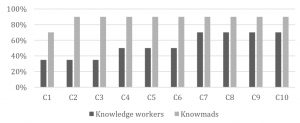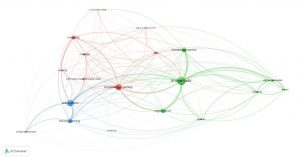
The emergence of “knowmads” as new knowledge workers
In the latter part of last century, Peter Drucker coined the now well-known term “knowledge worker” to describe1 someone who works with the knowledge they have gained through systematic education – that is, concepts, ideas, and theories – rather than someone who works with manual skills.
Now, knowledge management (KM) researchers are starting to document and explore the emergence of the “knowmad” as a new form of knowledge worker. John Moravec, who coined the term in 2008, defines2 a knowmad as:
a nomadic knowledge worker – that is, a creative, imaginative, and innovative person who can work with almost anybody, anytime, and anywhere. Industrial society is giving way to knowledge and innovation work. Whereas industrialization required people to settle in one place to perform a very specific role or function, the jobs associated with knowledge and information workers have become much less specific concerning task and place. Moreover, technologies allow for these new paradigm workers to work within broader options of space, including “real,” virtual, or blended. Knowmads can instantly reconfigure and recontextualize their work environments, and greater mobility is creating new opportunities.
To identify the key characteristics of knowmads, including the competencies that distinguish knowmad workers from knowledge workers, Andra Nicoleta Iliescu carried out a systematic review3 of the small but growing body of academic literature relating to knowmads.
Iliescu identifies ten key knowmad competencies from research4 by Bianca Garcia:
Ten key competencies of knowmads
C1. Highly inventive, collaborative, and intuitive, able to generate new ideas.
C2. Highly adaptable to new contexts and challenges. Unafraid of failure.
C3. Uses information and generates knowledge to solve unknown challenges in a variety of contexts.
C4. Able to create socially constructed meaning.
C5. Network generator, always connected to people, ideas, institutions, and organizations.
C6. Able to generate horizontal knowledge networks.
C7. Digital literate, knowledgeable on technology uses and purposes.
C8. Attentive to contexts and information adaptability and usage.
C9. Values and promotes knowledge-sharing and free access to information.
C10. Practices life-long learning: able to learn & unlearn quickly, adding new useful knowledge.
Figure 1 shows the estimated differences between knowledge workers and knowmads in regard to these ten key competencies:

As summarised by Iliescu, Garcia has also developed a knowmad role classification that includes six key roles:
Knowmad role classification
- Collector or retriever: Among key responsibilities are classification, organization, indexation of knowledge as well as linking, shaping, defining clusters of knowledge, charting relationships amongst different instances of a process or mapping, modeling, and establishing frameworks for knowledge allocation.
- Connector or networker: The connectors are collectors of relationships mainly because they are bringing people together. As such, they are connecting and engaging in valuable conversations.
- Communicator or sharer: Describes the activities of storytellers. Their responsibilities are information analysis and presentation, meeting the audience’s needs, creating reports, presentations and meeting records, briefing papers, and discussion documents that could facilitate knowledge sharing towards the different groups of interest.
- Creator or solver: Oversees the production of theories, models, and knowledge systems that other people follow. In this respect, he or she is often writing memos, manuals, articles, books, and reports as well as running experiments.
- Critic or tracker: In charge of knowledge analysis, identification of internal inconsistencies, procedure gaps, errors, risks, or development opportunities.
- Consumer or linker: Responsible for developing relationships based on trust, reputation, and ability to add value to the network.
After reading Iliescu and Garcia’s papers, important questions come to mind:
- How are the ten key competencies most effectively learned and transferred?
- How can employers make the best use of knowmads?
- Conversely, how can employers prevent the loss of critical knowledge if knowmads move on after a short time?
As the body of academic literature in regard to knowmads is currently small, it is understandable that these questions haven’t yet been explored, but it is hoped that KM researchers will make answering them a priority. This is because:
- a large number of workers who have been working from home during the COVID-19 pandemic want to keep doing so5, creating even more flexibility for people to work and live anywhere
- employee engagement has decreased through the COVID-19 pandemic, as anxiety levels increase and people question their own mortality, but only some employers are effectively addressing this6
- resignation rates have been increasing7 in the wake of the COVID-19 pandemic.
However, a second paper8 by Andra Nicoleta Iliescu provides some insights into how the ten key knowmad competencies are most effectively learned and transferred. Iliescu carried out a further systematic review of the academic literature on knowmads, this time adding a keyword co-occurrence analysis. The visualized results are shown in Figure 2:

In order of connection strength, the most significant clusters in Figure 2 are firstly “knowmads” in green, secondly “education” in blue, and thirdly “knowledge society” in red. An interesting aspect of the visualization is that even though directly connected through specific items, the “knowmads” cluster and “education” cluster appear to be separated by the “knowledge society” cluster. Building on the insights gained through her systematic review, Iliescu advises that this visual distribution can be explained as follows:
education is a fundamental concept associated with the knowmad workforce, but current education needs should be understood in a knowledge society … Consequently … all involved actors might need to prepare in specific ways for the upcoming work revolution: students, governments, academic institutions, business managers, and work professionals.
Header image source: Jan Vašek on Pixabay, Public Domain.
References:
- Kidd, A. (1994, April). The marks are on the knowledge worker. In Proceedings of the SIGCHI conference on Human factors in computing systems (pp. 186-191). ↩
- Moravec, J.W. (Ed.) (2013). Knowmad society. Education Futures. ↩
- Iliescu, A. N. (2021). The Emergence of Knowmads from the Knowledge Workers. Management Dynamics in the Knowledge Economy, 9(1), 94-104. ↩
- Garcia, B.C. (2012). New e-learning environments: e-merging networks in the relational society. In eLearning-Theories, Design, Software and Applications. IntechOpen. ↩
- Pew Research Center (2020, December). How the Coronavirus Outbreak Has – and Hasn’t – Changed the Way Americans Work. ↩
- Hu, J., He, W., & Zhou, K. (2020). The mind, the heart, and the leader in times of crisis: How and when COVID-19-triggered mortality salience relates to state anxiety, job engagement, and prosocial behavior. Journal of Applied Psychology, 105(11), 1218-1233. ↩
- U.S. Bureau of Labor Statistics (2021, October 12). Job Openings and Labor Turnover – August 2021. Economic News Release. ↩
- Iliescu, A. N. (2021). Conceptual Atlas of the Knowmad Literature: Visual Mapping with VOSviewer. Management Dynamics in the Knowledge Economy, 9(3), 379-392. ↩
Also published on Medium.







think I am one,
and/or liking the trailblazer concept for curator
This makes sense because a good Knowledge Manager should be able to be plug and play. Specialties such as law, medical, and a few others just require the KM to learn the legal portions.